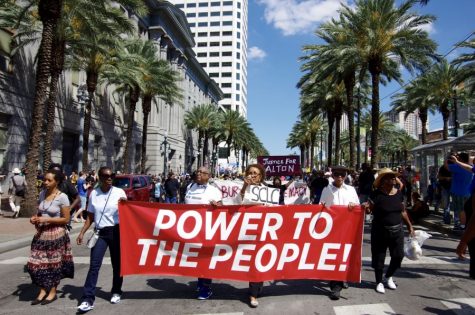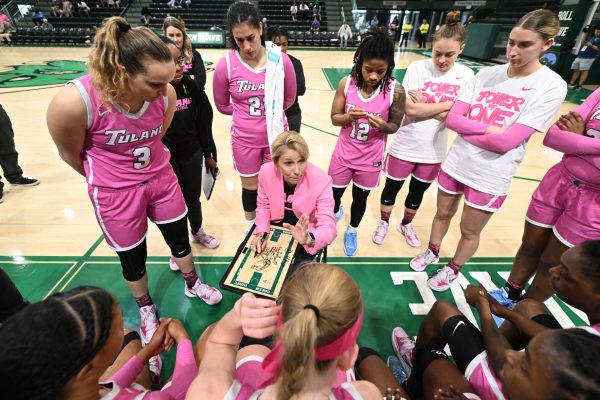New Orleans takes down Confederate monuments
Amid rising temperatures and tensions, New Orleanians gathered last month at Lee Circle to watch the removal of the Robert E. Lee statue, the city’s fourth removal of a monument since the New Orleans City Council passed legislation calling for removal of Confederate monuments earlier this year.
The Liberty Place Monument, the statue of Confederate President Jefferson Davis, the statue of Confederate General P.G.T. Beauregard and the Robert E. Lee monument have all been removed.
People from many areas of New Orleans, along with students at Tulane, took part in events including “The Celebrating of the Coming Down” second line to commemorate the removal of the monuments.
Sam Barton, rising junior and board member of Feminist Alliance of Students at Tulane, is heavily involved in Take ‘Em Down Nola and worked under the program leaders Malcolm Suber and Angela Kinlaw to raise awareness about the effort in New Orleans and on Tulane’s campus through events, flyers, social media posts and event transportation.
“I think more and more people in New Orleans are starting to see the connection between symbols and systems,” Barton said. “Obviously, the physical removal of a monument doesn’t change the fact that New Orleans is a city which continues to perpetuate its white supremacist past, but I think people might start to realize that if you can remove a statue, you can change a lot more.”
Angela Kinlaw, “Celebrating of the Coming Down” second line leader, gave some reasons to support the movement.
“It is time to be in the light,” Kinlaw said. “They didn’t mind being in the light when they were oppressing you. They didn’t mind celebrating in the light of day when they were holding you down. So we are going to celebrate the burials of symbols to white supremacy.”
“This is what democracy looks like,” the crowd at the “Celebrating the Coming Down” second line chanted in response to Kinlaw’s words.

“The Celebrating of the Coming Down” second line marched from Louis Armstrong Park to Lee Circle.
Some New Orleanians have, however, opposed the legislation calling for removal of the monuments. After 44 years of living in New Orleans, Richard Marksbury, associate professor of Asian Studies and former dean at Tulane, said he believes that the monuments should have stayed in place.
“I believe very strongly in people being able to preserve cultural heritage,” he said during a New York Times Facebook live discussion.
Marksbury also touched on the slippery slope he believes the city is creating by starting to take down monuments, noting that certain groups of people will feel differently about every monument displayed across the city and nation and the connection to their heritage.
“It’s a decision based on emotions, but all kinds of people have emotions,” Marksbury said. “Where exactly does it end? … Everybody, the billions of us on this planet, have emotions. So who gets to choose whose emotions are more important than somebody else’s emotions?”
Marksbury said he believes that the money, effort and time put into removing and replacing the monuments should be used to improve upon other issues facing New Orleans and Louisiana.
“I don’t think our education system is going to improve, murder rates are going to go down and political corruption is going to end with these down,” he said.
Mayor Mitch Landrieu has been working on his proposal to take down the monuments since 2015.
Landrieu crafted the proposal after the 2015 massacre of nine black parishioners at a South Carolina church. The shooter, Dylann Roof, had brandished Confederate symbols in photos. Roof’s use of these symbols sparked a debate about the citywide display of symbols which to many represent the historic oppression of black people.
Mayor Landrieu said that the reason behind his proposal was to create symbols in the city that represent the diversity of New Orleans instead of a history representing the Confederacy and enslavement.
Though this legislation was passed, Barton said he believes that the effort is not over and that Tulane students in particular need to keep creating change within the Tulane community.
“I’d say that the best way for anyone, and especially anyone who has attended a Take ‘Em Down NOLA event, to understand and address these issues is to join Students Organizing Against Racism, the White Anti-Racist Network at Tulane, the People of Color Collective and/or join or support multicultural organizations like GENTE or the Tulane Black Student Union,” Barton said.
Your donation will support the student journalists of Tulane University. Your contribution will allow us to purchase equipment and cover our annual website hosting costs.















Leave a Comment